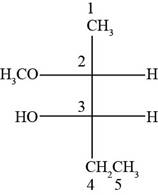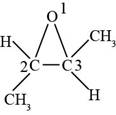
Concept explainers
Write structural formulas for the following compounds.
- a. ethyl isopropyl ether
- b. di-n-butyl ether
- c. 2-ethoxyoctane
- d. divinyl ether
- e. allyl methyl ether
- f. cyclohexene oxide
- g. cis-2,3-epoxyhexane
- h. (2R, 3S)-2-methoxypentan-3-ol
- i. trans-2,3-dimethyloxirane
(a)
Interpretation:
The structure formula for the given compound is to be drawn.
Concept introduction:
An organic compound where an oxygen atom is attached to two alkyl or aryl groups is known as ether. The general formula of ethers is
Answer to Problem 14.29SP
The structure of ethyl isopropyl ether is shown in Figure 1.
Explanation of Solution
The given compound is ethyl isopropyl ether. The root name isopropyl signifies three carbon atoms in a chain. Ethyl and isopropyl are the groups attached to an oxygen atom. The structure of ethyl isopropyl ether is shown below.

Figure 1
(b)
Interpretation:
The structure formula for the given compound is to be drawn.
Concept introduction:
An organic compound where an oxygen atom is attached to two alkyl or aryl groups is known as ether. The general formula of ethers is
Answer to Problem 14.29SP
The structure of di-n-butyl ether is shown in Figure 2.
Explanation of Solution
The given compound is di-n-butyl ether. The root name butyl signifies four carbon atoms in a chain and di-n-butyl indicates that two butyl groups are attached to an oxygen atom. The structure of di-n-butyl ether is shown below.

Figure 2
(c)
Interpretation:
The structure formula for the given compound is to be drawn.
Concept introduction:
An organic compound where an oxygen atom is attached to two alkyl or aryl groups is known as ether. The general formula of ethers is
Answer to Problem 14.29SP
The structure of 2-ethoxyoctane is shown in Figure 3.
Explanation of Solution
The given compound is 2-ethoxyoctane. The root octane signifies eight carbon atoms in a chain and 2-ethoxy shows that ethoxy group is present at second carbon atom of a chain. The structure of 2-ethoxyoctane is shown below.

Figure 3
(d)
Interpretation:
The structure formula for the given compound is to be drawn.
Concept introduction:
An organic compound where an oxygen atom is attached to two alkyl or aryl groups is known as ether. The general formula of ethers is
Answer to Problem 14.29SP
The structure of divinyl ether is shown in Figure 4.
Explanation of Solution
The given compound is divinyl ether. The Vinyl group is the functional group having a formula

Figure 4
(e)
Interpretation:
The structure formula for the given compound is to be drawn.
Concept introduction:
An organic compound where an oxygen atom is attached to two alkyl or aryl groups is known as ether. The general formula of ethers is
Answer to Problem 14.29SP
The structure of allyl methyl ether is shown in Figure 5.
Explanation of Solution
The given compound is allyl methyl ether. An allyl group is used as a substituent and has a formula of

Figure 5
(f)
Interpretation:
The structure formula for the given compound is to be drawn.
Concept introduction:
An organic compound where an oxygen atom is attached to two alkyl or aryl groups is known as ether. The general formula of ethers is
Answer to Problem 14.29SP
The structure of cyclohexene oxide is shown in Figure 6.
Explanation of Solution
The given compound is cyclohexene oxide. The root name cyclohexene signifies six carbon atoms in a ring and oxide indicated the presence of epoxide ring. The structure of cyclohexene oxide is shown below.

Figure 6
(g)
Interpretation:
The structure formula for the given compound is to be drawn.
Concept introduction:
An organic compound where an oxygen atom is attached to two alkyl or aryl groups is known as ether. The general formula of ethers is
Answer to Problem 14.29SP
The structure of
Explanation of Solution
The given compound is

Figure 7
(h)
Interpretation:
The structure formula for the given compound is to be drawn.
Concept introduction:
An organic compound where an oxygen atom is attached to two alkyl or aryl groups is known as ether. The general formula of ethers is
Answer to Problem 14.29SP
The structure of
Explanation of Solution
The given compound is
According to Fisher projection,
For
The structure of

Figure 8
(i)
Interpretation:
The structure formula for the given compound is to be drawn.
Concept introduction:
An organic compound where an oxygen atom is attached to two alkyl or aryl groups is known as ether. The general formula of ethers is
Answer to Problem 14.29SP
The structure of
Explanation of Solution
The given compound is

Figure 9
Want to see more full solutions like this?
Chapter 14 Solutions
Organic Chemistry (9th Edition)
- When 2-methylpropane is monochlorinated in the presence of light at room temperature, 36% of the product is 2-chloro-2-methylpropane and 64% is 1-chloro-2-methylpropane. From these data, calculate how much easier it is to remove a hydrogen atom from a tertiary carbon than from a primary carbon under these conditions.arrow_forwardWhy are hexane, cyclohexane, and toluene soluble in ligroin?arrow_forwardPhineas and Ferbs, two brothers who enjoy vacations, doing fun things every summer. This summer the brothers and their friends carry out an organic synthesis with an unknown compound (L1) that contains 52% Carbon, 6% Hydrogen and 42% bromine, this compound (L1) is treated with magnesium in ether to obtain L2 , which reacts violently with D2O for 1-methyl cyclohexene with a deuterium atom in the methyl group (L3). The L2 reaction is treated with acetone followed by hydrolysis to give L4. Heating L4 with concentrated sulfuric acid gives L5, which decolors the bromine, obtaining L6. L5 undergoes hydrogenation with excess hydrogen and platinum as a catalyst giving rise to isobutyl cyclohexane. Determine the structures of compounds L1 through L6.arrow_forward
- For each pair, give the relationship between the two compounds. Making models will be helpful.(a) (2R,3S)-2,3-dibromohexane and (2R,3R)-2,3-dibromohexanearrow_forwardDescribe three different methods of synthesizing aliens including dehydration of cohols,colors, elimination of alkyd halides and hydrogen of alkynes.write examples of each method and discuss the advantages and disadvantages of each method.arrow_forward1. Why are solutions of KMnO4 and Na2S2O3 generally stored in dark reagent bottles?arrow_forward
- Consider the following aromatic compounds a para-substituted compound?, the most reactive towards EAS? an ortho-substituted compound? does not react with RX, FeX3?arrow_forward1. Using Br2 in C2H4Br2 will result in HBr and ______. a. C2H3Cl3 b. C2H4Cl3 c. C2H2Cl3 d. none of the above 2. How many halogenation are posible in propane? a. 3 b. 8 c. 6 d. 10 3.Sulfonation of pentane will result in ________ and water. a. C5H11SO3H b. C5H12SO3H c. C5H14SO3H d. none of the above 4.Nitration of hexane will result in ________ and water. a. C6H13SO3H b. C6H15NO2 c. C6H13NO2 d. C6H14NO2 5.How many moles of O2 in heating a C12H26 (dodecane) a. 27 b. 37 c. 24 d. none of the abovearrow_forwardI need to know the names of these two structurers for my notes but I am not sure how to name them.arrow_forward
 ChemistryChemistryISBN:9781305957404Author:Steven S. Zumdahl, Susan A. Zumdahl, Donald J. DeCostePublisher:Cengage Learning
ChemistryChemistryISBN:9781305957404Author:Steven S. Zumdahl, Susan A. Zumdahl, Donald J. DeCostePublisher:Cengage Learning ChemistryChemistryISBN:9781259911156Author:Raymond Chang Dr., Jason Overby ProfessorPublisher:McGraw-Hill Education
ChemistryChemistryISBN:9781259911156Author:Raymond Chang Dr., Jason Overby ProfessorPublisher:McGraw-Hill Education Principles of Instrumental AnalysisChemistryISBN:9781305577213Author:Douglas A. Skoog, F. James Holler, Stanley R. CrouchPublisher:Cengage Learning
Principles of Instrumental AnalysisChemistryISBN:9781305577213Author:Douglas A. Skoog, F. James Holler, Stanley R. CrouchPublisher:Cengage Learning Organic ChemistryChemistryISBN:9780078021558Author:Janice Gorzynski Smith Dr.Publisher:McGraw-Hill Education
Organic ChemistryChemistryISBN:9780078021558Author:Janice Gorzynski Smith Dr.Publisher:McGraw-Hill Education Chemistry: Principles and ReactionsChemistryISBN:9781305079373Author:William L. Masterton, Cecile N. HurleyPublisher:Cengage Learning
Chemistry: Principles and ReactionsChemistryISBN:9781305079373Author:William L. Masterton, Cecile N. HurleyPublisher:Cengage Learning Elementary Principles of Chemical Processes, Bind...ChemistryISBN:9781118431221Author:Richard M. Felder, Ronald W. Rousseau, Lisa G. BullardPublisher:WILEY
Elementary Principles of Chemical Processes, Bind...ChemistryISBN:9781118431221Author:Richard M. Felder, Ronald W. Rousseau, Lisa G. BullardPublisher:WILEY





